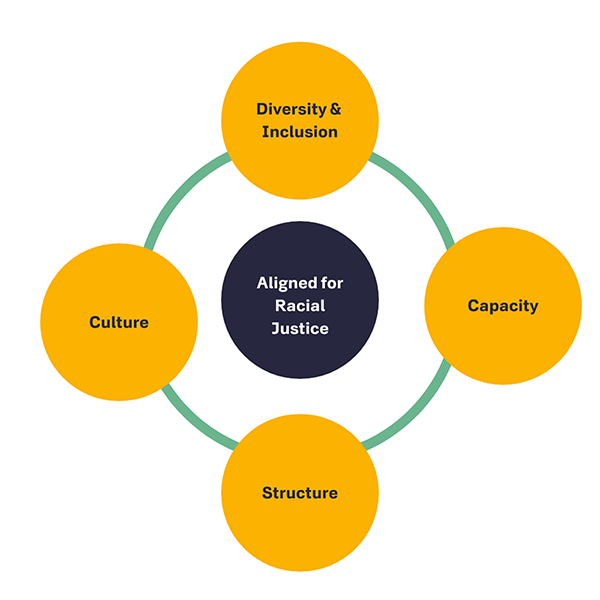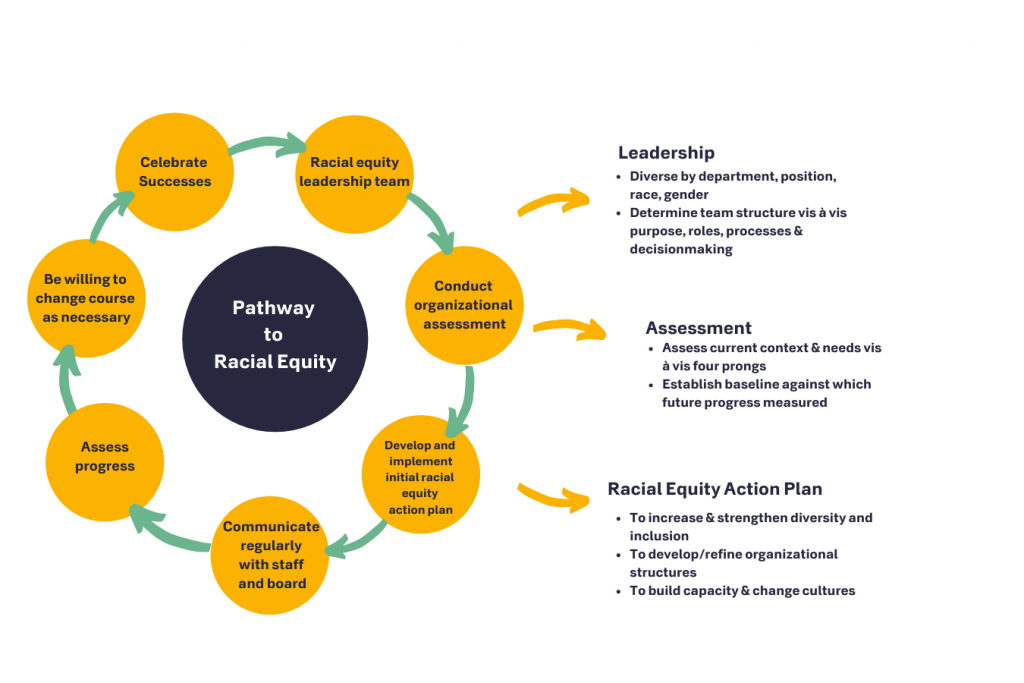
Although the pathway to organizational change can be challenging, groundwork can lay a helpful footing.
May 19, 2021
As collective consciousness around systemic racism has grown, many legal aid organizations are re-examining their internal policies and practices to ensure that they are not just serving communities of color but bringing a more intentional antiracist focus to that work. Establishing a commitment to advancing race equity and justice through advocacy is an important first step. But the greater challenge comes when seeking to operationalize that commitment.
The journey towards a diverse, equitable, and inclusive institution that is equipped to advance racial equity and justice both externally and internally can be complex. It requires organizational leadership to assess and modify organizational structures and culture. Throughout the process, staff must confront a wide range of issues, such as explicit and unconscious bias, microaggressions, stereotype threat, racism, and racial anxiety.
Although the path toward a more equitable organization is not always clear, groundwork can lay a helpful footing. The Shriver Center on Poverty Law helps advocacy organizations lead equitably and effectively to champion economic and racial justice through our Advocate Resources and Training program. Our approach starts with a four-prong framework to assess an organization’s readiness to engage in antiracist practice, which includes an assessment of (1) diversity and inclusion, (2) capacity, (3) structure, and (4) culture. This assessment provides an essential foundation for developing a successful racial equity action plan for staff to operationalize their commitments and transition to a more inclusive multi-cultural antiracist organization.

The first prong, Diversity and Inclusion, refers to the level of diversity by race within an organization across all roles and positional levels, and an inclusive environment where the entire staff can be and feel welcomed, respected, supported, valued and involved in decision-making that affects them. Staff diversity should mirror the demographics of the communities served by the organization. Moreover, that diversity should be reflected across all levels within the organization, including among staff who directly serves the community, leaders who guide the organization, the board that oversees the organization, the partners and allies with whom the organization chooses to engage, and individuals who donate to and support the organization.
The second prong, Capacity, refers to the knowledge, skills, and attitudes necessary to advance racial equity and justice both externally and within the organization. To engage in race equity advocacy, organizations must be equipped to understand the intersections between race and poverty; be comfortable and skillful in communicating these intersections; and understand the foundational concepts, skills, and tools needed to advance race equity. At a minimum, such capacity includes being able to recognize and work to dismantle structures that negatively impact communities of color; recognize and mitigate bias within and beyond the organization; engage in community lawyering, systems thinking, and framing of race equity issues; and participate in courageous conversations about race. Capacity also includes the ability to utilize critical race equity tools, such as racial equity mapping and impact assessments.
The third prong, Structure, refers to the organization’s policies and practices, including its mission, values, and vision. Strategic planning, which drives priority setting and budget allocations, must include and prioritize race equity. Client outreach and intake, as well as case selection guidelines, policy proposals, litigation, and other advocacy should reflect and focus on the communities within the organization’s service area that are most impacted by poverty and systemic racism. Hiring and promotion practices within organizations must be examined to eliminate bias and narratives that create and perpetuate homogenous, predominately white organizations.
Culture is the most challenging and elusive component of the four-part framework because it includes measurements of both quantitative and qualitative goals. In an antiracist organizational culture, people of color at all levels of the organization feel wholly included, respected, represented, and valued. Antiracist organizations encourage and support the creation of brave spaces for discussions on how racism, privilege, power, and oppression operate within the organization. People directly impacted by decisions must be included in those decision-making processes, and policies should be applied consistently, equitably, and transparently. Where policies and practices have the impact of benefiting white staff and disadvantaging or excluding staff of color, sufficient actions and interventions must be undertaken, as needed and on an ongoing basis, to interrupt patterns of white domination and power in day-to-day operations.

The pathway to organizational change can be challenging. Often, the process starts with a diverse team of staff and managers leading the work. This team must grapple with how and where to start the evolution and then shift towards operationalizing the organization’s racial equity commitments. They must clearly and consistently articulate why organizational change is essential to the mission. The team must also develop a structure for carrying out the work – how it will engage and communicate with essential stakeholders, how it will make decisions, and how it will assign roles and responsibilities to team members. A formal organizational assessment can be used to gauge the current climate within an organization, to bring awareness to challenges staff experience, to prioritize issues to be addressed through action-planning, and to create a baseline against which future progress will be measured.
The leadership team can then develop an action plan to address issues identified as priorities. The plan should outline how each issue will be addressed, who will be responsible for each step, and when each step will take place. Leadership should share the plan with staff to gain additional input and insight. Once implementation begins, constant communication on progress should be shared with staff on a regular basis.
One key component of a successful internal race equity plan is evaluation. Clear metrics of success should be defined at the outset. But organizations must also be nimble and prepared to change course, as necessary. Most important, staff should be encouraged to celebrate successes along the journey and use setbacks as an opportunity for growth.
Although the path toward organizational change and becoming an antiracist organization can be difficult, it is a journey worth taking. Laying a foundation through assessment of your organization’s culture and readiness, and making clear plans to operationalize your race equity plan, are important steps to take. With strong leadership committed to equity, and an engaged and diverse staff, organizations can evolve to better advocacy for economic and racial justice.
The Shriver Center connects and trains lawyers, community leaders, and activists nationwide to build the skills that are vital to social justice advocacy. Learn more.